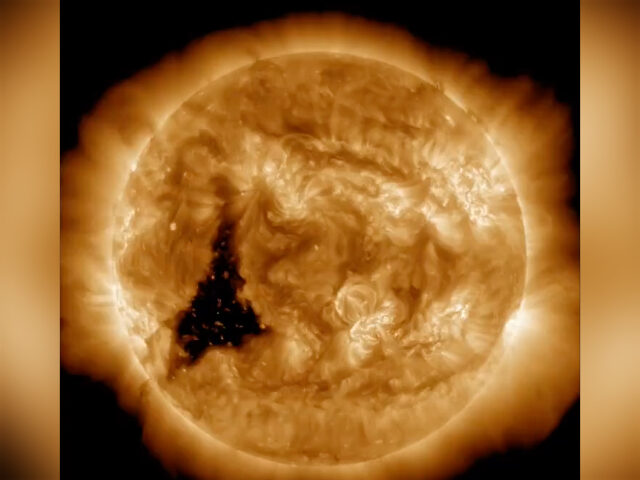An unprecedented “enormous dark hole” has opened in the sun’s surface and spewed streams of “unusually fast radiation” directly towards Earth, scientists say.
The giant dark patch, called a coronal hole, is wider than the size of 60 Earths put together, according to Space.com.
It is emitting radiation known as solar wind, and the hole’s size and orientation is “unprecedented at this stage of the solar cycle,” Harry Baker of Live Science wrote.
NASA shared a video loop of the massive patch on its Solar Dynamics Observatory website on Saturday.
The coronal hole formed close to the sun’s equator on December 2, reaching its maximum width of around 497,000 miles within 24 hours, Space Weather reported.
The scientific outlet warned that the solar wind radiation directed at Earth could cause mild to moderate “geomagnetic storms” — temporary disturbances in the Earth’s magnetosphere that could disturb electrical grids, satellites, and high-frequency communication systems.
By Wednesday, the hole was no longer directly pointing at Earth, so the radiation waves became less intense.
“Experts initially predicted this most recent hole could spark a moderate (G2) geomagnetic storm, which could trigger radio blackouts and strong auroral displays for the next few days,” Baker wrote. “However, the solar wind has been less intense than expected, so the resulting storm has only been weak (G1) so far…But auroras are still possible at high latitudes.”
While it is unclear how long the coronal hole will remain on the sun, previous dark patches have lasted for longer than a typical 27-day-long solar rotation in the past, the National Oceanic and Atmospheric Administration (NOAA) says.
There have been “numerous other signs that the sun is getting more active” over the last few weeks, according to Space.com:
On Nov. 18, a gigantic “sunspot archipelago” made up of at least five different sunspot groups emerged on the sun’s near side and has since spat out dozens of solar storms into space. On Nov. 25, an explosive “canyon of fire” eruption near the sun’s equator released a coronal mass ejection (CME) — a fast-moving cloud of magnetized plasma — that later slammed into Earth and triggered rare orange auroras. And on Nov. 28, an “almost X-class” solar flare shot out of the sun and birthed a cannibal CME that hit Earth and triggered a geomagnetic storm, which lit up lower latitudes with auroras over the weekend.
Scientists believe the sun’s recent surge in activity could be a sign “that we are right on the cusp of solar maximum,” the outlet said, referring to the peak in the sun’s 11-year solar cycle.
NOAA scientists announced their updated prediction for the sun’s maximum activity, saying it will come “between January and October of 2024, with a maximum sunspot number between 137 and 173.”
This is updated from a previous prediction that experts made in 2019, which claimed the current solar cycle would peak around July 2025, with a lower maximum sunspot number of 115.

COMMENTS
Please let us know if you're having issues with commenting.